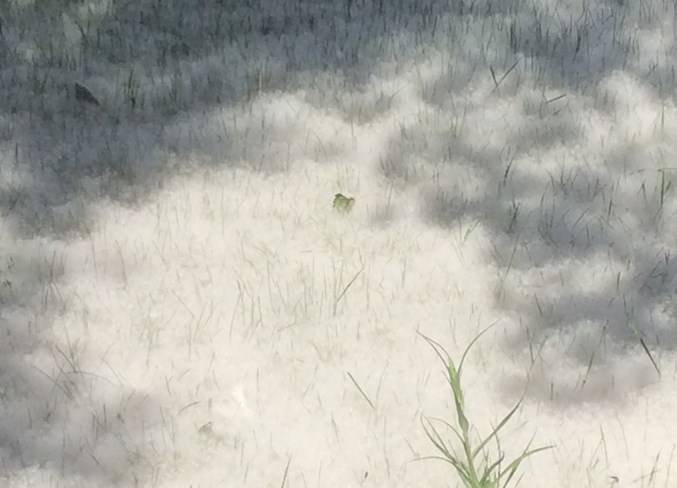Hot, dry and windy conditions this spring have led to a noticeable increase in white poplar fuzz in the Airdrie area, which might cause concerns about seasonal allergies – concerns Dr. Joel Doctor calls a misattribution. “What causes allergy this time of year is actually grass pollen,” he said. “People tend to look at the white fluffies flying around, have allergic symptoms and attribute it to the white fluffies, when, in fact, it’s much smaller particles of grass pollen floating around in the air…that are actually causing hay fever.” According to Doctor – a Calgary specialist in the field of allergy and clinical immunology – the white fluff floating in the air is actually the seed of plants like poplar and cottonwood trees. Doctor said the particles don’t contribute to allergic reactions, but can cause irritation from contact with eyes or sneezing due to inhalation. According to Jill Iverson, corporate communications team leader with the City of Airdrie, the fuzz in the area is the seed of the balsam poplar tree, a species native to the region. While Iverson said the City no longer buys or plants these trees, it also does not take steps to control the fuzz, as she said wind and rain will get rid of the particles naturally. While the fluff is not an allergen, Doctor said people may notice increased allergy symptoms this year. The same hot, dry and windy conditions conducive to the production of the fluffy seeds also leads plants to produce allergy-inducing pollen. “Once those conditions hit, then you get a lot more white fluffies around – and you also get a lot more grass pollen floating around, as well,” he said. According to Aerobiology Research Laboratories – an organization that monitors outdoor allergen levels – pollen levels in Calgary and the surrounding region have been higher this spring than they were last year. Poplar pollen is more than five times higher so far this year, and total tree pollen is already more than two times higher than in 2017. According to Doctor, about a third of the population is susceptible to developing allergies, including hay fever. Typically, hay fever is uncommon in children under the age of four, because they have not encountered pollen over enough seasons to trigger the allergy. “It often peaks in younger people – teens, 20s and 30s – and these individuals often have other allergy features,” Doctor said. “They may have asthma, they may have food allergies and they often also have a family history of allergy.” If someone is experiencing allergy symptoms for the first time, Doctor said it’s likely they’ve either just developed the allergy, or they’ve changed their lifestyle in a way that brings them into contact with more pollen. The fact that symptoms are manifesting in a year with increased pollen and seed is likely coincidental, he said. Doctor added pollen particles primarily affect the eyes and nose, not the respiratory system. “In a small subset of patients that have quite severe hay fever – especially if they are otherwise asthma prone – they might actually develop a bit of seasonal asthma, as well,” he said. “Worsening of their preexisting asthma during the allergy season is not uncommon, especially if the asthma is not quite well-controlled.” While symptoms like itchy eyes, runny nose and sneezing may seem innocuous, Doctor said they may impact on quality of life. A good first step to avoid hay fever is to reduce exposure to pollen by staying indoors on hot, dry or windy days. However, since many people want to spend summer days outdoors, Doctor said treating allergies can be the best recourse. “You can purchase over-the-counter… really excellent, non-drowsy antihistamines,” he said. Prescription medications might alleviate allergy symptoms if over-the-counter options don’t work, which Doctor said are a better alternative than simply switching antihistamines. “We do see a small subset of people in whom avoiding doesn’t work – the medications either don’t work or they’re not very well tolerated,” Doctor said. “In those cases, patients can undergo allergy desensitization, which essentially treats the allergy to make it less severe.”



